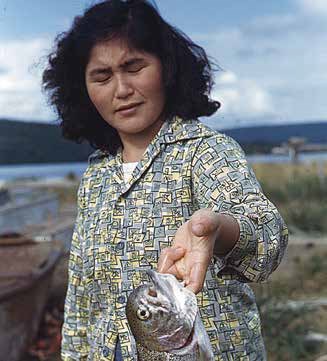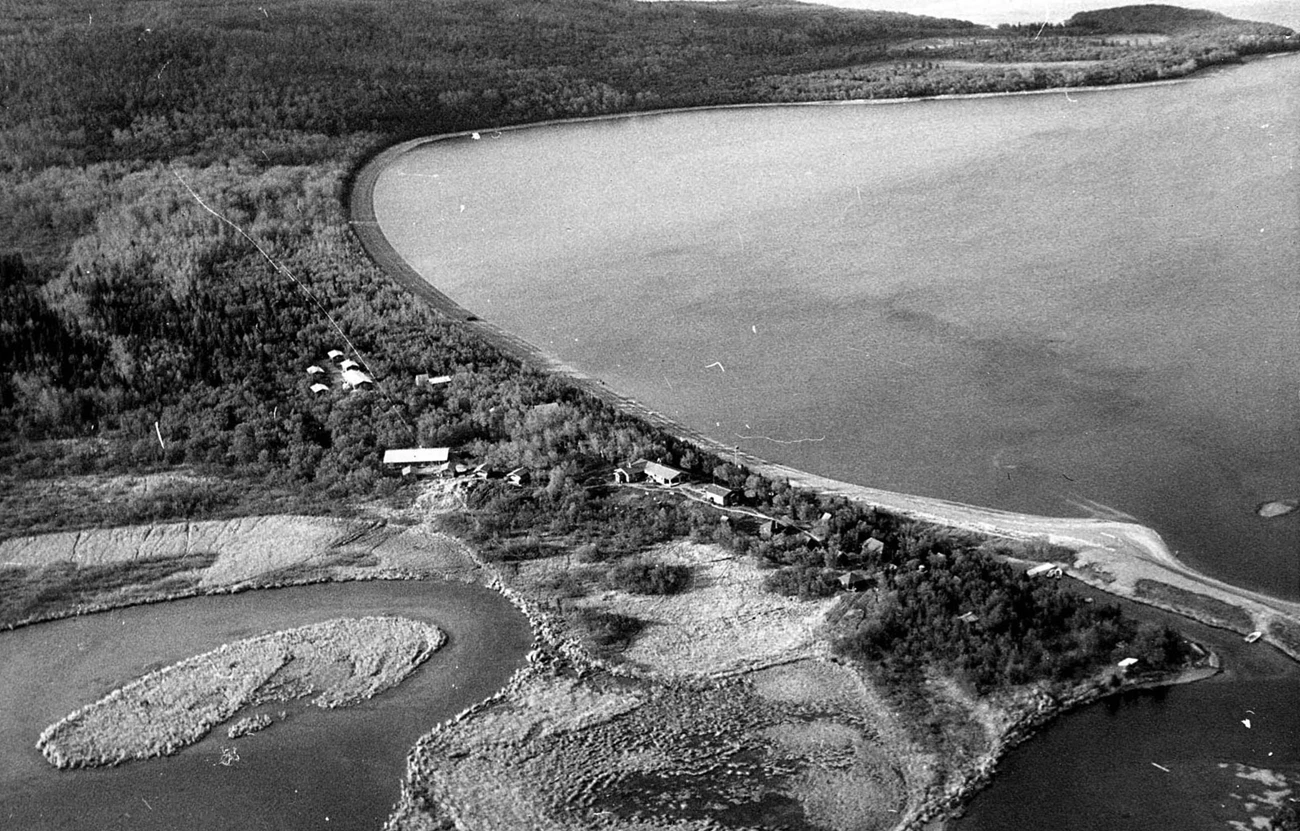Part of a series of articles titled Cultural Landscapes of Katmai National Park and Preserve.
Article
Brooks Camp Cultural Landscape
A Brief History

NPS / Alaska Regional Office
Opening the Monument
Brooks Camp Historic District is located on the west shore of Naknek Lake in Katmai National Park and Preserve. In 1918, with the designation of Katmai National Monument, the National Park Service history began in the area. In 1931, the monument’s boundaries expanded to include the Brooks River area. Though the NPS originally planned to disperse visitor destinations and park development throughout the monument, the remote, inaccessible setting made planning impossible. Katmai National Monument remained closed to the public from 1919 to 1949, with minimal management and no visitor services.
In 1950, the NPS contract with Petersen’s Northern Consolidated Airlines (NCA) was the first time an airline provided primary access to an NPS site and the first NPS concession lease issued to an airline. This opening of the monument coincided with the ecotourism movement, geared predominantly to sports fisherman. That year, NCA opened five fishing camps. In response to the need for regulation within the monument, the National Park Service stationed a single seasonal ranger at the modern campground before constructing a permanent ranger station.
Infrastructure Development
This significant change in visitation at Katmai during the 1950s and 1960s coincided with a period of development at Brooks Camp. The influx of tourists led to the creation of new concessionaire cabins and a lodge, as well as the development of the Valley of Ten Thousand Smokes Road and a cultural interpretation program. A broad range of visitors journeyed to Brooks Camp seeking a “Last Frontier” experience. The development ensured that Brooks Camp would function as a hub of activity for Katmai.
In the 1960s, the NPS and NCA developed Brooks Camp with a series of milled cedar log cabins, named “Pan Abodes,” after the company that produced them. Pan Abodes became the most identifiable architectural style in the park, critical to communicating the rustic ambiance of the region. By 1967, most of the camps, structures, trails, and roads associated with early tourism and park development had been built. Now, Brooks Camp serves as a destination for visitors to enjoy camping, fishing, bear watching, wilderness sightseeing, and exploration of Alaska’s cultural history. In many ways, land use at Brooks Camp displays a remarkable continuity: for at least 6,000 years, the area’s natural systems, especially fish, have drawn humans to the area.
Significance and Condition
-
Period of Significance: 1950 to 1968 CE
-
Significance Level: Local
-
National Register Significance Criteria:
-
Criterion A, in the areas of Conservation and Entertainment/Recreation
-
Criterion C, in the area of Architecture for the Pan Abode method of construction (eligible)
-
-
Landscape Type: Historic Vernacular Landscape
-
Condition: Fair— Implementing the 1996 Development Concept Plan as written will adversely affect the Brooks Camp landscape by removing eligible structures. Cyclic maintenance backlog, nesting and gnawing rodents, non-historic facades and additions to listed structures, and impacts from concessionaire and visitor use affects the integrity of the cultural landscape in the absence of proactive management.
Character Defining Features
The Brooks Camp Historic District has historic integrity according to the National Register. A major element of its integrity is the high degree of historic character conveyed through its landscape characteristics. These features include natural systems and features, spatial organization, land use, buildings and structures, circulation, views and vistas, and archeological sites. Smaller scale contributing features are the Brooks Camp Flagpole at Naknek Lake Beach and potentially the timber steps leading to the Brooks River Ranger Station. Together, this range of features conveys a strong sense of time and place, representing national park development and tourism in Alaska in the 1950s and 1960. It contributes to the landscape’s integrity of location, association, setting, feeling, materials, workmanship, and design.
The landforms and geology that surround Brooks River combine to form a dynamic watershed and gathering place where humans, animals, and nature interact. Because of their central role in the camp’s historic land use, hydrological features such as the Brooks Lake, Brooks River, Brooks Falls, and Naknek Lake are considered contributing natural features to the Brooks Camp landscape. These unique hydrological features also make Brooks Camp home to important types of wildlife. One of the most notable is the anadromous salmon, millions of which migrate up the river every year to spawn, attracting humans, bears, and other fish species. The salmon provide a food source for large predators and a recreation opportunity for people. Besides brown bears and humans, the landscape is also a gathering area for wolves, lynx, fox, moose, beaver, birds, and small terrestrial mammals.

NPS
Buildings and Structures
Pan Abode Construction
A Pan Abode constructed cabin is a prefabricated, milled, western red cedar planking that is assembled in a manner similar to log construction.
-
3”x6”, single tongue-and-groove cedar log construction
-
Low-pitched metal roof with deep overhanging eaves
-
Overlapping notches at the corners with bear bar corner
-
Original wood-framed, multi-light picture windows
-
Recessed entrance with rounded corners

NPS
NPS Log Construction
The Brooks River Ranger Station, Boat Storage House, and Elevated Ranger Cache represent the early period of tourism and park management in Katmai National Monument.
-
Alternating large and small spruce logs construction
-
Peeled saddle-notched log walls
-
Quartered split log chinking
-
Rock pier foundation
-
Gable roof supported by purlins, exposed rafters
-
Corrugated metal roofing on board stringers

NPS / C. Bell
Views
-
View of the Brooks River from the core concessionaire area
-
Views from the beach to Naknek Lake
-
Views of Dumpling Mountain
Circulation
Trails of particular importance include:
-
Axial trail leading from the concessionaire lodge to NPS Ranger Station
-
Trail to the NPS campground
-
Trail leading down to the river from the concessionaire office

NPS Archives
Natural Systems
-
Lower Brooks River and the falls
-
Naknek Lake
-
Anadromous salmon migrations
Land Use
-
The predominant land use from ancestral times to the present has been for the harvesting of natural resources, namely salmon and other fish species.
-
Historic era site use includes indigenous fish camps and seasonal homes.
-
Tourism evolved from sports fishing in the 1950s to include people seeking to experience the “Last Frontier.”
-
Bears began appearing in larger numbers around the camp in 1966 attracting visitors dedicated to bear viewing.

NPS / Katmai National Park and Preserve Archives (A2623)
Brooks Camp Historic District and Cultural Landscape Map
Last updated: November 20, 2023




